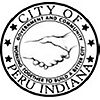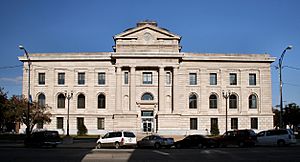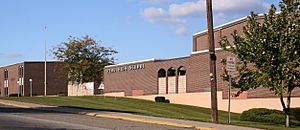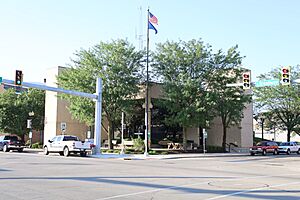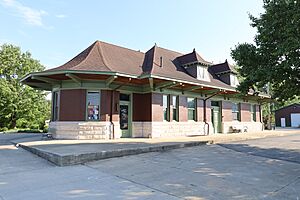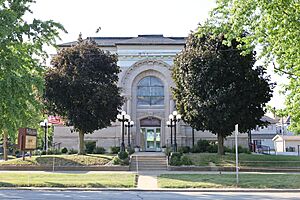Peru, Indiana facts for kids
Quick facts for kids
Peru, Indiana
|
||
|---|---|---|
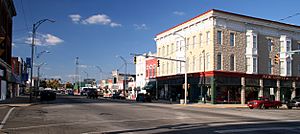
Peru downtown
|
||
|
||
| Nickname(s):
Circus Capital of the World
|
||
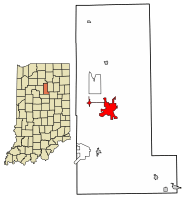
Location in Miami County, Indiana
|
||
| Country | United States | |
| State | Indiana | |
| County | Miami | |
| Townships | Peru, Washington | |
| Founded | 1834 | |
| Founded by | William N. Hood | |
| Area | ||
| • Total | 5.14 sq mi (13.32 km2) | |
| • Land | 5.06 sq mi (13.09 km2) | |
| • Water | 0.09 sq mi (2.27 km2) 1.69% | |
| Elevation | 650 ft (200 m) | |
| Population
(2020)
|
||
| • Total | 11,073 | |
| • Density | 2,190.1/sq mi (845.6/km2) | |
| Time zone | UTC-5 (Eastern (EST)) | |
| • Summer (DST) | UTC-4 (EDT) | |
| ZIP codes |
46970-46971
|
|
| Area code(s) | 765 | |
| FIPS code | 18-59328 | |
| GNIS feature ID | 2396188 | |
Peru is a city in Indiana, USA. It is the main city, or county seat, of Miami County. It's about 73 miles north of Indianapolis. In 2020, about 11,073 people lived there, making it the biggest town in Miami County. Peru is located along the Wabash River. It's also part of a larger area called the Kokomo-Peru Combined Statistical Area.
Most people in Peru say the city's name like the country Peru. Some older residents might use an older way of saying it, like "PEE-roo."
Contents
History of Peru
The land where Peru now stands was first bought on August 18, 1827. Joseph Holman bought it from Jean Baptiste "Pechewa" (Wildcat) Drouet de Richardville. He was the chief of the Miami people. President John Quincy Adams approved the sale in 1828. In 1829, Holman planned out a town called Miamisport.
Peru was officially started in 1834 by William N. Hood. He had bought 210 acres of land from Joseph Holman five years earlier. By 1835, Peru became the main town in the area. The name "Miamisport" was no longer used. In 1837, Frances Slocum met her family near Peru. She had lived with Native Americans for almost 60 years.
In the early 1900s, Peru had a car company called Model Automobile Company. Like many early car makers, it did not last.
In 1913, Peru faced a huge flood. It was the worst flood at that time. From March 24 to March 27, about 6 inches of rain fell. Water from the Wabash and Mississinewa rivers rushed through the streets. It moved at speeds of 20 miles per hour, destroying many things. Before this flood, Peru was a busy town. It had 15,000 people and many jobs. There were 100 factories, a trolley, railroads, and a new hospital. A circus also employed 1,000 people. The total damage in Peru was about $3,000,000 in 1913 money.
In 1933, a famous criminal named John Dillinger and his group took weapons from the Peru police station.
On June 23, 1972, a man named Martin J. McNally took over American Airlines Flight 119. He got money and then jumped out of the plane. The money and a weapon were found near Peru. A local farmer found the money in a sealed bag. Another farmer found a submachine gun in his corn field.
The movie Little Big Top was filmed in Peru. It starred Sid Haig. Ward Roberts, who grew up in Peru, wrote and directed the movie. You can see famous places like the "Mr. Weenie" restaurant and the Circus building in the film.
Several historic buildings in Peru are listed on the National Register of Historic Places. These include the Brownell Block/Senger Dry Goods Company Building, James Omar Cole House, Miami County Courthouse, Peru High School Historic District, and Shirk-Edwards House.
Circus History
Peru was once the winter home for many famous circuses. These included the Hagenbeck–Wallace and Buffalo Bill's Wild West Show. The International Circus Hall of Fame is located in Peru. Every year in July, the Peru Amateur Circus puts on shows. Young performers, aged 7 to 21, take part. The week ends with the Circus City Festival and Parade. Peru is also home to the only company in the world that still makes steam calliopes. These are musical instruments that use steam.
Mariya Rasputina, the daughter of Grigori Rasputin, once worked for the Hagenback-Wallace Circus in Peru. She was hurt by a bear but survived.
Geography of Peru
Peru is in north-central Indiana. It is in the middle of Miami County. It is 14 miles west of Wabash and 16 miles east of Logansport. Indianapolis, the state capital, is 73 miles south. South Bend is 71 miles north.
Peru covers about 5.14 square miles. Most of this area is land, and a small part is water. The Wabash River flows through the city from east to west. The neighborhood of South Peru is across the river. The Mississinewa River joins the Wabash about 1 mile east of the city.
Peru is the largest town in Miami County. It is also where the main office of the Miami Nation is located.
Transportation in Peru
Highways for Travel
U.S. Route 31 (business route) goes north and south through Peru. It uses North Broadway and West Main Street. U.S. Route 24 (business route) goes east and west through Peru. It uses East and West Main Street. The main U.S. 24 is a four-lane road about 1.5 miles north of downtown. The main U.S. 31 is a four-lane road about 3 miles west of downtown. Peru's city limits reach these highways.
Indiana State Road 19 also goes through the center of Peru. It uses Chili Avenue, North Benton Street, East Main Street, and South Broadway. It goes north 8 miles to Chili. It goes southeast 14 miles to Amboy. State Road 124 (East Riverside Drive) goes east from South Peru 27 miles to Mount Etna.
Railroad Connections
Peru used to be a stop for Wabash Railroad trains. These trains traveled between St. Louis and Detroit. The last train on that line was the Wabash Cannon Ball in 1971. The last Amtrak passenger train service ended in 1986.
In 2024, the only railroad left in Peru is the Norfolk Southern Railway.
Air Travel
The Peru Municipal Airport is run by the city. It is about 5 miles northwest of downtown Peru.
Peru's Population
| Historical population | |||
|---|---|---|---|
| Census | Pop. | %± | |
| 1850 | 1,266 | — | |
| 1860 | 2,506 | 97.9% | |
| 1870 | 3,617 | 44.3% | |
| 1880 | 5,280 | 46.0% | |
| 1890 | 7,028 | 33.1% | |
| 1900 | 8,463 | 20.4% | |
| 1910 | 10,910 | 28.9% | |
| 1920 | 12,410 | 13.7% | |
| 1930 | 12,730 | 2.6% | |
| 1940 | 12,432 | −2.3% | |
| 1950 | 13,308 | 7.0% | |
| 1960 | 14,453 | 8.6% | |
| 1970 | 14,139 | −2.2% | |
| 1980 | 13,764 | −2.7% | |
| 1990 | 12,843 | −6.7% | |
| 2000 | 12,994 | 1.2% | |
| 2010 | 11,417 | −12.1% | |
| 2020 | 11,073 | −3.0% | |
| U.S. Decennial Census | |||
Population in 2010
In 2010, there were 11,417 people living in Peru. There were 4,791 households and 2,961 families. The city had about 2,234 people per square mile. Most residents (93.1%) were White. Other groups included African American (2.5%), Native American (1.3%), and Asian (0.4%). About 2.4% of the population was Hispanic or Latino.
About 30.8% of households had children under 18. Many households (42.0%) were married couples. The average household had 2.36 people. The average family had 2.96 people.
The average age in Peru was 39 years old. About 24.5% of residents were under 18. About 15.6% were 65 or older. The city was 47.5% male and 52.5% female.
Education in Peru
Peru has a public library called the Peru Public Library.
Famous People from Peru
Many notable people have connections to Peru, Indiana:
- Mary Newbury Adams, who worked for women's voting rights and education.
- Richard Antrim, a Medal of Honor winner.
- Alfred Bergman and Arthur Bergman, who were football players and coaches.
- Arthur G. Elvin, an engineer and businessman who was also a mayor.
- Frank Fetter, an economist.
- Albert Fredrick Ottomar Germann and Frank Erhart Emmanuel Germann, who were chemists.
- Bob Gibbs, a former Congressman from Ohio.
- Emmett Kelly, a famous circus clown.
- Kyle Macy, a former basketball player and coach.
- Keith O'Conner Murphy, a singer and songwriter.
- Ole Olsen, a comedian.
- B. J. Penn, who served as a Secretary of the Navy.
- Cole Porter, a very famous songwriter, was born in Peru.
- Ralph Richeson, an actor.
- Emil Schram, who was president of the New York Stock Exchange.
- G. David Thompson, an investment banker and art collector.
- Robert Edward Weaver, an artist and professor.
- Nancy Wilson-Pajic, an artist honored by France.
- John Ross Woodring, a newspaper editor.
- Carol Lou Woodward, a pianist.
- Amy Shuman, an HR specialist.
See also
 In Spanish: Peru (Indiana) para niños
In Spanish: Peru (Indiana) para niños


